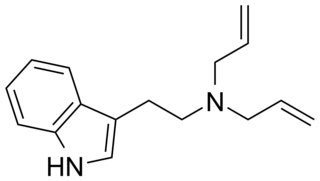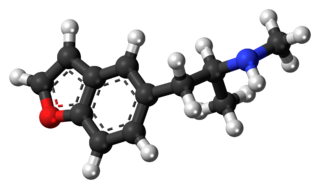
5-MeO-DALT or N,N-di allyl-5-methoxy tryptamine is a psychedelic tryptamine first synthesized by Alexander Shulgin.

Phthalimidopropiophenone is a chemical intermediate used in the synthesis of cathinone. It has been found to be sold on the illicit market as a controlled substance analogue, but little is currently known about its pharmacology or toxicology.

Dimethocaine, also known as DMC or larocaine, is a compound with a stimulatory effect. This effect resembles that of cocaine, although dimethocaine appears to be less potent. Just like cocaine, dimethocaine is addictive due to its stimulation of the reward pathway in the brain. However, dimethocaine is a legal cocaine replacement in some countries and is even listed by the European Monitoring Centre for Drugs and Drug Addiction (EMCDDA) under the category “synthetic cocaine derivatives”. The structure of dimethocaine, being a 4-aminobenzoic acid ester, resembles that of procaine. It is found as a white powder at room temperature.

JWH-018 (1-pentyl-3-(1-naphthoyl)indole, NA-PIMO or AM-678) is an analgesic chemical from the naphthoylindole family that acts as a full agonist at both the CB1 and CB2 cannabinoid receptors, with some selectivity for CB2. It produces effects in animals similar to those of tetrahydrocannabinol (THC), a cannabinoid naturally present in cannabis, leading to its use in synthetic cannabis products that in some countries are sold legally as "incense blends".

Arylcyclohexylamines, also known as arylcyclohexamines or arylcyclohexanamines, are a chemical class of pharmaceutical, designer, and experimental drugs.

3',4'-Methylenedioxy-α-pyrrolidinobutyrophenone (MDPBP) is a stimulant of the cathinone class developed in the 1960s, which has been reported as a novel designer drug. MDPBP is sometimes sold under the name "NRG-1" as a mixture with other cathinone derivatives, including flephedrone, pentylone, MαPPP and its higher homologue MDPV. As with other cathinones, MDPBP has been shown to have reinforcing effects in rats.

N,N-Diallyltryptamine (DALT) is a tryptamine derivative which has been identified as a new psychoactive substance. It has been used as an intermediate in the preparation of radiolabeled diethyltryptamine.

Methiopropamine (MPA) is an organic compound structurally related to methamphetamine. Originally reported in 1942, the molecule consists of a thiophene group with an alkyl amine substituent at the 2-position. It appeared for public sale in the UK in December 2010 as a "research chemical" or "legal high", recently branded as Blow. It has limited popularity as a recreational stimulant.

4-Methylethcathinone or 4-MEC is a chemical that bears a chemical resemblance to mephedrone. Due to its similarity to mephedrone, it is thought to be a stimulant and entactogen drug of the phenethylamine, amphetamine, and cathinone chemical classes. It has been marketed alone or in mixtures with other substituted cathinones under the name "NRG-2", although other blends such as "NRG-1" may have been more ambiguous with their ingredients.

5-MAPB is an entactogenic designer drug similar to MDMA in its structure and effects.

6-MAPB is a psychedelic and entactogenic drug which is structurally related to 6-APB and MDMA. It is not known to have been widely sold as a "designer drug" but has been detected in analytical samples taken from individuals hospitalised after using drug combinations that included other benzofuran derivatives. 6-MAPB was banned in the UK in June 2013, along with 9 other related compounds which were thought to produce similar effects.

Diphenidine is a dissociative anesthetic that has been sold as a designer drug. The synthesis of diphenidine was first reported in 1924, and employed a Bruylants reaction analogous to the one that would later be used to discover phencyclidine in 1956. Shortly after the 2013 UK ban on arylcyclohexylamines, diphenidine and the related compound methoxphenidine became available on the grey market. Anecdotal reports describe high doses of diphenidine producing "bizarre somatosensory phenomena and transient anterograde amnesia." Diphenidine and related diarylethylamines have been studied in vitro as treatments for neurotoxic injury and are antagonists of the NMDA receptor. In dogs diphenidine exhibits greater antitussive potency than codeine phosphate.

Methoxphenidine is a dissociative of the diarylethylamine class that has been sold online as a designer drug. Methoxphenidine was first reported in a 1989 patent where it was tested as a treatment for neurotoxic injury. Shortly after the 2013 UK ban on arylcyclohexylamines methoxphenidine and the related compound diphenidine became available on the gray market, where it has been encountered as a powder and in tablet form. Though diphenidine possesses higher affinity for the NMDA receptor, anecdotal reports suggest methoxphenidine has greater oral potency. Of the three isomeric anisyl-substituents methoxphenidine has affinity for the NMDA receptor that is higher than 4-MeO-Diphenidine but lower than 3-MeO-Diphenidine, a structure–activity relationship shared by the arylcyclohexylamines.

3-Fluorophenmetrazine is a phenylmorpholine-based stimulant and fluorinated analogue of phenmetrazine that has been sold online as a designer drug.

Ephenidine is a dissociative anesthetic that has been sold online as a designer drug. It is illegal in some countries as a structural isomer of the banned opioid drug lefetamine, but has been sold in countries where it is not yet banned.

MDMB-CHMICA is an indole-based synthetic cannabinoid that is a potent agonist of the CB1 receptor and has been sold online as a designer drug. While MDMB-CHMICA was initially sold under the name "MMB-CHMINACA", the compound corresponding to this code name (i.e. the isopropyl instead of t-butyl analogue of MDMB-CHMINACA) has been identified on the designer drug market in 2015 as AMB-CHMINACA.

Nifoxipam is a benzodiazepine that is a minor metabolite of flunitrazepam and has been sold online as a designer drug.

Methoxypiperamide is a psychoactive drug of the piperazine class that has been sold online as a designer drug. It is the 4-methoxy-α-keto analog of methylbenzylpiperazine.

4-EA-NBOMe is a substituted amphetamine and 25-NB derivative which has been sold as a designer drug. It was first identified by a forensic laboratory in Germany in 2014, but while its analytical properties and metabolism have been studied, its pharmacology remains unknown.
4-Ethylamphetamine (4-EA) is a substituted amphetamine derivative which has been sold as a designer drug. It is mainly known as a synthetic intermediate used as a building block to manufacture larger molecules, but 4-EA is closely related in chemical structure to designer drugs such as 4-methylamphetamine and 4-ethylmethcathinone, and is both a synthetic precursor and a metabolite of the 25-NB derivative 4-EA-NBOMe.



















